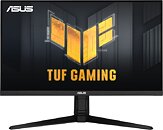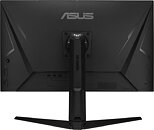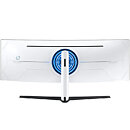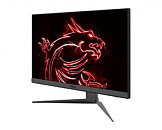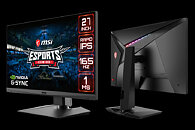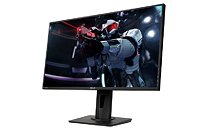Mar 25th, 2025 19:12 EDT
change timezone
Latest GPU Drivers
New Forum Posts
- Windows 11 General Discussion (5898)
- Has anyone tried enabling FSR 4 on NVIDIA cards? (2)
- HalfLife2 RTX Demo Is out! (316)
- RX 9070 availability (232)
- Did Nvidia purposely gimp the performance of 50xx series cards with drivers (40)
- Post your Speedometer 3.0 Score (114)
- RTX 5080 worth it over 5070 TI for 4k? (54)
- Question about Intel Optane SSDs (52)
- Biostar RX 6700 XT OC BIOS (9)
- Do you use Linux? (550)
Popular Reviews
- Assassin's Creed Shadows Performance Benchmark Review - 30 GPUs Compared
- be quiet! Pure Rock Pro 3 Black Review
- ASUS ProArt X870E-Creator Wi-Fi Review
- ASRock Radeon RX 9070 XT Taichi OC Review - Excellent Cooling
- Sapphire Radeon RX 9070 XT Nitro+ Review - Beating NVIDIA
- ASUS GeForce RTX 5070 TUF OC Review
- Pulsar Feinmann F01 Review
- AMD Ryzen 9 9950X3D Review - Great for Gaming and Productivity
- AMD Ryzen 7 9800X3D Review - The Best Gaming Processor
- Quick Look: Jelly Key Mystic Snake Artisan Keycaps
Controversial News Posts
- AMD RDNA 4 and Radeon RX 9070 Series Unveiled: $549 & $599 (260)
- AMD Radeon RX 9070-series Pricing Leaks Courtesy of MicroCenter (158)
- MSI Doesn't Plan Radeon RX 9000 Series GPUs, Skips AMD RDNA 4 Generation Entirely (142)
- Microsoft Introduces Copilot for Gaming (123)
- AMD Radeon RX 9070 XT Reportedly Outperforms RTX 5080 Through Undervolting (118)
- NVIDIA Reportedly Prepares GeForce RTX 5060 and RTX 5060 Ti Unveil Tomorrow (115)
- Over 200,000 Sold Radeon RX 9070 and RX 9070 XT GPUs? AMD Says No Number was Given (100)
- NVIDIA GeForce RTX 5050, RTX 5060, and RTX 5060 Ti Specifications Leak (96)
News Posts matching #G-Sync Compatible
Return to Keyword Browsing
Dell Launches Two New Alienware QD-OLED Gaming Monitors, Starting at US$550
Back in January, Dell/Alienware announced the 27-inch 4K AW2725Q QD-OLED monitor, which is now being joined by the 27-inch 2560 x 1440 resolution AW2725D and the 34-inch 3440 x 1440 resolution AW3425DW, both also sporting a QD-OLED panel. The AW3425DW offers a 240 Hz refresh rate, a 0.03 ms grey to grey response time and a peak brightness of 1000 cd/m². The monitor is NVIDIA G-Sync Compatible, as well as AMD FreeSync Premium Pro and VESA AdaptiveSync certified and it supports HDMI VRR for console gamers. Dell has equipped it with one DP 1.4 port, two HDMI 2.1 ports—there's support for both picture by picture and picture in picture, something normally only seen on more business savvy monitors—one USB Type-B upstreams and one USB Type-A as well as one Type-C downstream ports, all being limited to a 5 Gbps data rate, although the Type-C port supports 15 W device charging.
As for the AW2725D, we're looking at a 280 Hz refresh rate, but Dell didn't provide much else in terms of specifications, as this model isn't expected to be available until sometime this summer. However, it will be the cheapest QD-OLED monitor from Dell's Alienware brand at US$549.99. The AW3425DW will have an MSRP of US$799.99 which it launches on April 29th. Finally, the AW2725Q which launches today, will retail at the announced US$899.99. All three models will come with a three year OLED burn-in warranty.
As for the AW2725D, we're looking at a 280 Hz refresh rate, but Dell didn't provide much else in terms of specifications, as this model isn't expected to be available until sometime this summer. However, it will be the cheapest QD-OLED monitor from Dell's Alienware brand at US$549.99. The AW3425DW will have an MSRP of US$799.99 which it launches on April 29th. Finally, the AW2725Q which launches today, will retail at the announced US$899.99. All three models will come with a three year OLED burn-in warranty.

Samsung's New 2025 Monitors Delivers 27-inch 4K OLED 240 Hz Gaming Performance, AI Capabilities, and Enhanced Productivity
Samsung Electronics today unveiled its 2025 Smart Monitor, Odyssey Gaming Monitor and ViewFinity Monitor lineups, all of which will be on display at Samsung's First Look at CES on January 5. The 2025 models raise the bar for monitors by bringing AI features, industry-first sizes in the OLED market and new form factors that ignite the passions of users worldwide—whether they're working, gaming or creating.
"With the new monitors in our industry-leading lineups, we're giving people more ways to explore the content and connections that they love in new ways," said Hoon Chung, Executive Vice President of Visual Display Business at Samsung Electronics. "Because of our new AI capabilities and size options, 2025 will see users across the world find the right monitor that fits them."
"With the new monitors in our industry-leading lineups, we're giving people more ways to explore the content and connections that they love in new ways," said Hoon Chung, Executive Vice President of Visual Display Business at Samsung Electronics. "Because of our new AI capabilities and size options, 2025 will see users across the world find the right monitor that fits them."

ASUS Upcoming ROG Swift OLED PG27UCDM is a 27-inch 4K 240 Hz Gaming Monitor
ASUS has published the product page for its upcoming ROG Swift OLED PG27UCDM gaming monitor, which will go head to head with the MSI MPG272URX on which will hit retail as the first 27-inch 4K 240 Hz display. The PG27UCDM sports a 26.5-inch panel using what ASUS refers to as 4th gen QD-OLED technology, which the company claims offer longer lifespan compared to previous generations of OLED panels. The panel sports typical OLED features such as a 0.03 ms response time, a peak brightness of 1,000 cd/m², 99 percent DCI-P3 colour space coverage and VESA DisplayHDR 400 True Black. The display also supports AMD FreeSync Premium Pro and NVIDIA G-Sync compatible, as well as a host of ASUS specific gaming features such as ELMB, GameFast Input Technology, Shadow Bost and a DisplayWidget.
Inputs consist of a DisplayPort 2.1 port with UHBR20 (80 Gbps) support, a USB Type-C with DP-Alt mode and USB PD up to 90 W and a pair of HDMI 2.1 ports. There's also a three port USB 3.2 Gen 1 (5 Gbps) USB hub with what we presume is a USB Type-B input and a headphone jack. The reason for the presumed USB Type-B input, is that the specs claim KVM support and this would only be possible if there was a USB input of some kind, but this isn't mentioned in the tech specs. The stand is your typical higher-end model with tilt, swivel, pivot and height adjustment, as well as ASUS' Aura Sync lighting and a tripod mount at the top. ASUS claims a power consumption of around 80 Watts, although this doesn't include USB PD. A big plus is that ASUS will bundle a DisplayPort 2.1 DP80 cable in the box, something for example Sony decided not to include with their INZONE M9 II which launched in September last year. There's no word on pricing for the ROG Swift OLED PG27UCDM, but expect it to be on the expensive side of US$1,000.
Inputs consist of a DisplayPort 2.1 port with UHBR20 (80 Gbps) support, a USB Type-C with DP-Alt mode and USB PD up to 90 W and a pair of HDMI 2.1 ports. There's also a three port USB 3.2 Gen 1 (5 Gbps) USB hub with what we presume is a USB Type-B input and a headphone jack. The reason for the presumed USB Type-B input, is that the specs claim KVM support and this would only be possible if there was a USB input of some kind, but this isn't mentioned in the tech specs. The stand is your typical higher-end model with tilt, swivel, pivot and height adjustment, as well as ASUS' Aura Sync lighting and a tripod mount at the top. ASUS claims a power consumption of around 80 Watts, although this doesn't include USB PD. A big plus is that ASUS will bundle a DisplayPort 2.1 DP80 cable in the box, something for example Sony decided not to include with their INZONE M9 II which launched in September last year. There's no word on pricing for the ROG Swift OLED PG27UCDM, but expect it to be on the expensive side of US$1,000.

AGON by AOC Launches the Q27G4XY Smart Gaming Monitor Featuring Google TV
Your favorite shows, movies, series, live TV, and games are in your space on the screen of your AGON by AOC Q27G4XY SMART GAMING MONITOR. The AGON by AOC Q27G4XY 27" SMART GAMING MONITOR is a pioneer in this field, bringing the convenience of Google TV to your monitor screen. This 27" QHD 2560x1440 WLED monitor, featuring a 180 Hz refresh rate, 1 ms GtG response time, AMD FreeSync, NVIDIA G-SYNC, and HDR10, combined with Google TV, delivers an immersive gaming and streaming experience—ideal for any dorm room!
Google TV
When you're done gaming, there's no need to switch devices. The AGON by AOC Q27G4XY Smart Gaming Monitor, powered by Google TV's built-in operating system, brings all your entertainment to one place. Instantly browse movies, shows, live TV, sports, and more across your favorite apps. Google TV brings together everything you stream on one screen, so you can find what to watch without jumping from app to app. Not sure what to watch? Just ask Google Assistant and search across apps with your voice to find what you're looking for. Finding your next watch is now as easy as ever.
Google TV
When you're done gaming, there's no need to switch devices. The AGON by AOC Q27G4XY Smart Gaming Monitor, powered by Google TV's built-in operating system, brings all your entertainment to one place. Instantly browse movies, shows, live TV, sports, and more across your favorite apps. Google TV brings together everything you stream on one screen, so you can find what to watch without jumping from app to app. Not sure what to watch? Just ask Google Assistant and search across apps with your voice to find what you're looking for. Finding your next watch is now as easy as ever.

ASUS Launches Glossy 1440p WOLED Gaming Monitor
Today is a good day for those of you that have wanted a glossy OLED gaming monitor, as ASUS has launched the ROG Strix OLED XG27AQDMG, which is a glossy WOLED gaming monitor. The ROG Strix OLED XG27AQDMG sports a 2560 x 1440 pixel WOLED display with a 240 Hz refresh rate and a 0.03 ms grey to grey response time. ASUS also claims up to 20 percent brighter image in SDR mode and deeper black hues under any lighting conditions, quite something to live up to. On the more technical side, the panel is said to offer a 1.5 million to one contrast ratio, support for 99 percent of the DCI-P3 colour space or 135 percent of the RGB colour space and it's should also have 10-bit colour support.
Connectivity wise, there will be disappointing sights from some, as the ROG Strix OLED XG27AQDMG relies on a single DP 1.4 with DSC and a pair of HDMI 2.0 ports for video inputs, which means the HDMI ports are limited to 144 Hz. It also only has two USB 3.2 Gen 1 5 Gbps ports and no USB Type-C input, although there's a headphone jack for those that want to use that. Other features include FreeSync Premium and G-Sync Compatible support, as well as ASUS' trace free technology, GamePlus, shadow boost and OLED care. No word on official pricing at this point in time, but it's non-glossy counterpart retails for US$900.
Update May 21st: ASUS has announced the offical pricing for the ROG Strix OLED XG27AQDMG and the MSRP is US$699, which makes it around US$200 cheaper than its non-glossy counterpart. It'll go on sale from the 30th of May.
Connectivity wise, there will be disappointing sights from some, as the ROG Strix OLED XG27AQDMG relies on a single DP 1.4 with DSC and a pair of HDMI 2.0 ports for video inputs, which means the HDMI ports are limited to 144 Hz. It also only has two USB 3.2 Gen 1 5 Gbps ports and no USB Type-C input, although there's a headphone jack for those that want to use that. Other features include FreeSync Premium and G-Sync Compatible support, as well as ASUS' trace free technology, GamePlus, shadow boost and OLED care. No word on official pricing at this point in time, but it's non-glossy counterpart retails for US$900.
Update May 21st: ASUS has announced the offical pricing for the ROG Strix OLED XG27AQDMG and the MSRP is US$699, which makes it around US$200 cheaper than its non-glossy counterpart. It'll go on sale from the 30th of May.

LG Unveils Pricing and Full Specs on a Further Three UltraGear OLED Gaming Monitors
Following its high-end 4K UltraGear pricing reveal, LG has released the full specs and pricing on a further three SKUs that were also announced back in December of last year. The models in question are the 34GS95QE, 39GS95QE and 45GS95QE, all of which sport a 3440 x 1440 resolution. As the model names suggest, we're looking at 34, 39 and a massive 45-inch display panel in these monitors. Other common denominators are that all three models are curved at 800R and a 240 Hz refresh rate, as well as a 21:9 aspect ratio. All three models also feature FreeSync Premium Pro and G-Sync support, a 275 cd/m² typical brightness and a 0.03 ms GtG response time.
Inputs also appear to be shared across the range with all models offering two HDMI 2.1 inputs and one DP 1.4, plus one USB 3.2 Type-B input and at least a pair of Type-A outputs and a headset jack. The stands are limited to height, tilt and swivel adjustments due to the curved nature of the displays. Price wise, these new OLED models are unlikely to sell as hotcakes, as the 34GS95QE starts at US$1,299.99, followed by the 39GS95QE at US$1,499.99 and finally the 45GS95QE at US$1,699.99. Considering that there are similar displays with lower refresh rates from several competitors at far lower price points, LG is likely going to have to offer some hefty discounts for these new models before they start selling in any kind of quantity.
Inputs also appear to be shared across the range with all models offering two HDMI 2.1 inputs and one DP 1.4, plus one USB 3.2 Type-B input and at least a pair of Type-A outputs and a headset jack. The stands are limited to height, tilt and swivel adjustments due to the curved nature of the displays. Price wise, these new OLED models are unlikely to sell as hotcakes, as the 34GS95QE starts at US$1,299.99, followed by the 39GS95QE at US$1,499.99 and finally the 45GS95QE at US$1,699.99. Considering that there are similar displays with lower refresh rates from several competitors at far lower price points, LG is likely going to have to offer some hefty discounts for these new models before they start selling in any kind of quantity.

LG Quietly Launches the UltraGear 27GR75Q-B QHD Gaming Monitor
LG has launched what appears to be something of a budget model in its UltraGear range of gaming monitors in the shape of the UltraGear 27GR75Q-B. What we're looking at is a 2560 x 1440 resolution display with a refresh rate of up to 165 Hz, which not so long ago would've made this a premium product in the 1440p monitor segment. However, taking a closer look at the specifications, it's pretty clear that this is more of a budget model, as it only supports HDR10 and has a typical brightness of 300 nits and a minimum brightness of a mere 240 nits. You still get an IPS panel at least, although we're not sure how LG can claim it has a 1 ms grey to grey response time, as that's not something commonly found in IPS displays.
Other gaming features include FreeSync Premium and G-Sync Compatible support and LG's various gaming features, such as black stabilizer, dynamic action sync and an OSD feature that allows you to add a crosshair. Connectivity consists of two HDMI ports which top out at 144 Hz and one DP 1.4 port that tops out at 165 Hz, as well as a 3.5 mm audio jack. The monitor is at least fairly power efficient with a maximum power draw of 48 W and a typical power consumption of 45 W. The stand supports tilt, height and pivot adjustment. We found the UltraGear 27GR75Q-B listed for sale in Hong Kong for around US$250, confirming that this is indeed a more budget friendly option from LG.
Other gaming features include FreeSync Premium and G-Sync Compatible support and LG's various gaming features, such as black stabilizer, dynamic action sync and an OSD feature that allows you to add a crosshair. Connectivity consists of two HDMI ports which top out at 144 Hz and one DP 1.4 port that tops out at 165 Hz, as well as a 3.5 mm audio jack. The monitor is at least fairly power efficient with a maximum power draw of 48 W and a typical power consumption of 45 W. The stand supports tilt, height and pivot adjustment. We found the UltraGear 27GR75Q-B listed for sale in Hong Kong for around US$250, confirming that this is indeed a more budget friendly option from LG.

AOC Q24G2A QHD 24-Inch Gaming Monitor Coming to European Markets
The Q24G2A/BK is an apparent best selling model in the Chinese gaming monitor market, and AOC has decided to make its popular 23.8-inch 1440p gaming-focused screen available to European customers. It is slightly unusual for a small monitor to feature such a high pixel density (123 pixels per inch), thanks to the 2560×1440 QHD specification - but buoyant sales figures in China indicate that the region's gamers favor higher resolutions within a compact frame. AOC is now motivated enough to bring the IPS-based Q24G2A to a western audience - where tastes could be different - although there is no word about any upcoming availability in North American territories.
The western equivalent of China's popular Q24G2 model (launched in that region last year) has been updated and fitted with a pair of internal stereo speakers (rated at 2 W each), and the overall aesthetic is quite familiar - the Q24G2A/BK looks to share the same chassis (plus stand) with the cheaper/lower spec 24G2U/BK model. AOC is touting an MSRP of €249 for its European customers, and that pricing is a bit eyebrow raising - larger 27-inch IPS QHD gaming monitors sit comfortably in this price bracket. Pixel density enthusiasts could favor the smaller AOC since it beats out the twenty-seven inchers in terms of sharpness (123 vs 108 PPI). It is speculated that AOC has sourced the Q24G2A/BK's IPS-ADS panel from BOE Technology.
The western equivalent of China's popular Q24G2 model (launched in that region last year) has been updated and fitted with a pair of internal stereo speakers (rated at 2 W each), and the overall aesthetic is quite familiar - the Q24G2A/BK looks to share the same chassis (plus stand) with the cheaper/lower spec 24G2U/BK model. AOC is touting an MSRP of €249 for its European customers, and that pricing is a bit eyebrow raising - larger 27-inch IPS QHD gaming monitors sit comfortably in this price bracket. Pixel density enthusiasts could favor the smaller AOC since it beats out the twenty-seven inchers in terms of sharpness (123 vs 108 PPI). It is speculated that AOC has sourced the Q24G2A/BK's IPS-ADS panel from BOE Technology.

LG Launches 45-inch Ultra Wide OLED Monitor for Gaming
If LG's 27-inch 1440p OLED monitor wasn't your cup of tea, the company has launched a second UltraGear branded gaming OLED monitor with an entirely different form factor. The UltraGear 45GR95QE-B as it's known as, is a 45-inch ultra wide monitor with a 3440 x 1440 pixel resolution, giving it an aspect ratio of 21:9. As with the 27-inch 27GR95QE-B, we're looking at a 240 Hz refresh rate here and the same 0.03 ms GtG response time and the ability to display up to 1.07 billion colours. However, this is where the similarities end, as the 45GR95QE-B's massive panel means that LG made it a curved display and it's very curved at 800R. Despite its enormous size, it has a pixel pitch of a mere 84 PPI, which is very low, especially as a normal pixel pitch for a 3440 x 1440 display is somewhere around 110 PPI on a 34-inch display, which places this closer to a 27-inch 1080p display.
The monitor has two HDMI and one DP input, as well as one upstreams and two downstreams USB 3.0 ports. It also has an S/PDIF out, a headphone jack with DTS HP:X support and a barrel plug for an external 19.5 Volt power brick. LG doesn't provide a typical power consumption, but the power brick can deliver 210 Watts. It also comes with a remote, for changing the settings. Other features include VRR, FreeSync Premium and G-Sync Compatible support. It also has the same gaming features as LG's other UltraGear monitors. The supplied stand supports tilt, height and swivel adjustments. For those considering this massive display, which measures almost a metre wide, make sure your desk can handle the weight, as it comes in at almost 11 kg. LG's asking price for this beast of a monitor isn't for those with a tight budget, as it's a rather steep US$1,699.99.
The monitor has two HDMI and one DP input, as well as one upstreams and two downstreams USB 3.0 ports. It also has an S/PDIF out, a headphone jack with DTS HP:X support and a barrel plug for an external 19.5 Volt power brick. LG doesn't provide a typical power consumption, but the power brick can deliver 210 Watts. It also comes with a remote, for changing the settings. Other features include VRR, FreeSync Premium and G-Sync Compatible support. It also has the same gaming features as LG's other UltraGear monitors. The supplied stand supports tilt, height and swivel adjustments. For those considering this massive display, which measures almost a metre wide, make sure your desk can handle the weight, as it comes in at almost 11 kg. LG's asking price for this beast of a monitor isn't for those with a tight budget, as it's a rather steep US$1,699.99.

Alienware Announces 24.5-Inch 1080p 360 Hz and 27-Inch 1440p 280 Hz Monitors
Dell has launched a pair of new gaming focused displays under its Alienware badge and both are high refresh rate monitors. The 25-inch (or rather 24.5-inch) model goes under the model name AW2523HF and has a 1080p panel with a 360 Hz refresh rate. It supports Freesync Premium and it also supports VESA AdaptiveSync. It's said to have a 400 nits peak brightness fast IPS panel that has a colour gamut that covers 99 percent of the sRGB spectrum. Inputs consist of one DP 1.4 and two HDMI 2.0 ports, as well as a USB-B 3.0 input and four USB-A 3.0 outputs
The 27-inch model is called the AW2723DF and it sports 1440p resolution and here we're looking at a fast nano IPS panel that has a native 240 Hz refresh rate, but it can be pushed up to 280 Hz using an overclocking option. It supports FreeSync Premium, G-sync Compatible and AdaptiveSync, so here all your bases are covered regardless of which GPU you hook it up to. It's also an HDR 600 display with a typical peak brightness of 450 cd/m² and it has a wider colour gamut that supports 95 percent of the DCI-P3 spectrum. This is still an edge lit display, so don't expect amazing HDR performance. Connectivity is the same as for the AW2523HF, although it's said to support Picture-by-Picture and Picture-in-Picture, which the 25-inch model apparently doesn't. The AW2523HF will be available in early September for $450, while the AW2723DF will launch in early October for $650.
The 27-inch model is called the AW2723DF and it sports 1440p resolution and here we're looking at a fast nano IPS panel that has a native 240 Hz refresh rate, but it can be pushed up to 280 Hz using an overclocking option. It supports FreeSync Premium, G-sync Compatible and AdaptiveSync, so here all your bases are covered regardless of which GPU you hook it up to. It's also an HDR 600 display with a typical peak brightness of 450 cd/m² and it has a wider colour gamut that supports 95 percent of the DCI-P3 spectrum. This is still an edge lit display, so don't expect amazing HDR performance. Connectivity is the same as for the AW2523HF, although it's said to support Picture-by-Picture and Picture-in-Picture, which the 25-inch model apparently doesn't. The AW2523HF will be available in early September for $450, while the AW2723DF will launch in early October for $650.

ASUS ROG Strix XG32UQ Brings HDMI 2.1 and 4K at 160 Hz
ASUS has unveiled its first 32-inch ROG Strix monitor with 4K resolution in the shape of the XG32UQ. It comes with all the features you'd expect from a modern 4K display, such as HDMI 2.1 and a 120 Hz mode for consoles. It obviously also has a DP 1.4 port and supports up to 160 Hz refresh rate thanks to its Fast IPS panel. It's certified for FreeSync Premium Pro and is G-Sync Compatible, as well as having a DisplayHDR 600 certification. Oddly enough, ASUS didn't implement USB-C support, nor can the XG32UQ function as a KVM, a feature that has become pretty standard on higher-end monitors like this. It does have a USB 3.2 Gen 1 (5 Gbps) Type-B input and two USB 3.2 Gen 1 Type-A outs though.
The panel meets 96 percent of the DCI-P3 and 130 percent of the sRGB colour space and the typical brightness in SDR mode is 450 cd/m². ASUS has also implemented it's game visual features and what the company calls extreme low motion blur. The panel comes factory calibrated, so the XG32UQ should be possible to use for work as well as gaming. ASUS has also taken a leaf out of Corsair's playbook by implementing a screw mount at the top of the stand, to which something like a webcam mount could be fitted. There's no word on pricing, but based on pricing for similar products, we'd hazard a guess that it'll end up around the $1000 mark.
The panel meets 96 percent of the DCI-P3 and 130 percent of the sRGB colour space and the typical brightness in SDR mode is 450 cd/m². ASUS has also implemented it's game visual features and what the company calls extreme low motion blur. The panel comes factory calibrated, so the XG32UQ should be possible to use for work as well as gaming. ASUS has also taken a leaf out of Corsair's playbook by implementing a screw mount at the top of the stand, to which something like a webcam mount could be fitted. There's no word on pricing, but based on pricing for similar products, we'd hazard a guess that it'll end up around the $1000 mark.

ASUS TUF Gaming Introduces the VG32AQL1A Monitor: 32" Fast IPS, QHD, 170 Hz, DisplayHDR 400
ASUS today via its TUF Gaming brand introduced the VG32AQL1A monitor, which is sure to tick a lot of boxes for many people looking for a gaming monitor. The 32" diagonal may put some off due to the typical distance users sit away from the monitor. The 2560 x 1440 Fast IPS panel features a 1 ms response time and 170 Hz refresh rate - as well as support for FreeSync Premium and NVIDIA's G-Sync Compatible program. In addition to the fast response time and refresh rates, the ASUS TUF Gaming VG32AQL1A also features ELMB sync (for black frame insertion and motion blur reduction) as well as a smart, "variable overdrive" setting that dynamically changes monitor overdrive values according to the current frame rate so as to further reduce motion blur.
Typical brightness is set at a standard 300 cd/m², with peak brightness achieving the 400 cd/m² that enables this monitor to boast of VESA's Display HDR 400 certification. Contrast ratio is 1,000:1, and color coverage stands at 99% of the DCI-P3 standard. I/O is ensured by 1x DisplayPort 1.2, 2x HDMI 2.0, 2x USB 3.0, 1x earphone jack, and 2x 2 W stereo speakers. Usability is improved by the stand's support for -5 to 20 ° tilt, -10 to 10 ° swivel, and 0 to 90 mm height adjustments. No pricing information was available at time of writing.
Typical brightness is set at a standard 300 cd/m², with peak brightness achieving the 400 cd/m² that enables this monitor to boast of VESA's Display HDR 400 certification. Contrast ratio is 1,000:1, and color coverage stands at 99% of the DCI-P3 standard. I/O is ensured by 1x DisplayPort 1.2, 2x HDMI 2.0, 2x USB 3.0, 1x earphone jack, and 2x 2 W stereo speakers. Usability is improved by the stand's support for -5 to 20 ° tilt, -10 to 10 ° swivel, and 0 to 90 mm height adjustments. No pricing information was available at time of writing.

Samsung Updating Odyssey G9 Premium Gaming Monitor - MiniLED Technology, First DisplayHDR 2000 Certification?
A listing has surfaced on Chinese website Taobao featuring what is being described as the 2021 update for the ultra-premium Samsung Odyssey G9 gaming monitor. It keeps the DNA of the Odyssey G9 - that means the 49" VA panel, 5120×1440 resolution and 1000R curvature remain. The devil, as always, is in the details; the new monitor is expected to feature a MiniLED backlight solution featuring 2048 dimming zones, which should enable a contrast ratio of 4,000:1 and an eventual, first-of-its-kind DisplayHDR 2000 certification by VESA. The current maximum under the standard stands at DisplayHDR 1400, so it's quite the jump for maximum HDR quality.

MSI Announces Optix G242 eSports Monitor: 24" 1080p, IPS, 144 Hz, VRR, 250 nits
MSI today announced yet another addition to their gaming monitor staple in the form of the Optix G242. This monitor drops the MAG prefix, denoting a higher-end solution, and should therefore (and according to its specs) be priced lower than those solutions. The Optix G242 features a relatively small, 24" diagonal that offers up an IPS panel with 1080p resolution. A now "normal" 144 Hz refresh rate is served up in that package, and perhaps more interestingly, the panel displays up to 16.7 million colors covering a wide color gamut display coverage rated at 94.6% DCI-P3 and 127.7% sRGB. VRR is also supported for additional gaming capabilities, either in the form of FreeSync or NVIDIA's G-Sync Compatible branding.
The 250 nits maximum brightness are nothing to write home about; that said, the Optix G242 features MSI's "AntiFlickr" technology and an incorporated "Blue Light Reduction" filtering mode. Contrast is quoted at 1000:1. I/O is assured by 1x DisplayPort 1.2, 2x HDMI 1.4, and 1x Earphone jack. Body sizing is a beautiful (as all supposedly are) 540.2 mm width, 228.2 mm depth, 411.6 mm height, and 3.33 kg. No word on pricing or availability were available at time of writing.
The 250 nits maximum brightness are nothing to write home about; that said, the Optix G242 features MSI's "AntiFlickr" technology and an incorporated "Blue Light Reduction" filtering mode. Contrast is quoted at 1000:1. I/O is assured by 1x DisplayPort 1.2, 2x HDMI 1.4, and 1x Earphone jack. Body sizing is a beautiful (as all supposedly are) 540.2 mm width, 228.2 mm depth, 411.6 mm height, and 3.33 kg. No word on pricing or availability were available at time of writing.

AOC Announces the AGON AG493UCX Monitor: 49" VA, 5120 x 1440, 120 Hz, 1ms, 32:9, FreeSync and DisplayHDR 400
AOC has announced a new addition to their AGON line of gaming monitors in the form of the AGON AG493UCX. This is a beastly monitor with a 49" diagonal and 5K resolution with a Super Ultra-Wide aspect ratio of 32:9 (with a resolution of 5120 x 1440 pixels). The panel type is VA, which promises increased contrast ratios against those typically found in IPS panels (3000:1, in this case). AOC is promising 120 Hz refresh rates with a 1 ms (MPRT) response times with MBR backlight. There is also support for VRR technologies such as FreeSync and G-Sync (compatible).
Display brightness is quoted at 550 cd/m², which is just shy of a DisplayHDR 600 certification, but comfortably achieves the VESA DisplayHDR 400 certification. The monitor isn't a slouch in terms of color display either, being better than your average VA panel: the display is factory-calibrated and ships with a guaranteed dE <2, and coverage for 16.7 millions colors across a 93% DCI-P3 gamut coverage (and 121% sRGB coverage). I/O is handled by 2x DisplayPort 1.4, 2x HDMI 2.0, 1x USB type-C, 3x USB ports and 1x an audio output. 2x 5 W speakers are built in to the screen and the stand offers tilt, height and swivel adjustments. No word on pricing as of yet.
Update December 10th 2020: AOC has just made the AGON AG493UCX available for purchase. Initial availability is pegged for Europe with a price tag set at £899 / €899.
Display brightness is quoted at 550 cd/m², which is just shy of a DisplayHDR 600 certification, but comfortably achieves the VESA DisplayHDR 400 certification. The monitor isn't a slouch in terms of color display either, being better than your average VA panel: the display is factory-calibrated and ships with a guaranteed dE <2, and coverage for 16.7 millions colors across a 93% DCI-P3 gamut coverage (and 121% sRGB coverage). I/O is handled by 2x DisplayPort 1.4, 2x HDMI 2.0, 1x USB type-C, 3x USB ports and 1x an audio output. 2x 5 W speakers are built in to the screen and the stand offers tilt, height and swivel adjustments. No word on pricing as of yet.
Update December 10th 2020: AOC has just made the AGON AG493UCX available for purchase. Initial availability is pegged for Europe with a price tag set at £899 / €899.

MSI Announces Optix MAG274QRF-QD Monitor
MSI, the world's leading manufacturer for true gaming hardware, is proudly expanding the hardware possibilities for all gamers. This time, we are honored to introduce our latest eSports Gaming Monitor: Optix MAG274QRF-QD. Equipped with a Rapid IPS panel, the latest technology that delivers 4x faster response time than normal IPS panels, the Optix MAG274QRF-QD will give you all the competitive advantages you need. Experience extremely smooth and tear-free gameplay with built-in NVIDIA G-Sync Compatible technology, 165hz high refresh rate, and 1 ms GTG fast response time.
Performance matters a lot, but it would be a great pity if the beautiful details in the games are lost. This wouldn't be a problem with the Optix MAG274QRF-QD. The WQHD (2560x1440) high resolution and Quantum Dot technology will produce the most mesmerizing images. Enjoy every scene as if you are living within. Always improving, MSI will keep on challenging itself in the design of gaming monitors, and ensure that you are always ahead of your opponents.
Performance matters a lot, but it would be a great pity if the beautiful details in the games are lost. This wouldn't be a problem with the Optix MAG274QRF-QD. The WQHD (2560x1440) high resolution and Quantum Dot technology will produce the most mesmerizing images. Enjoy every scene as if you are living within. Always improving, MSI will keep on challenging itself in the design of gaming monitors, and ensure that you are always ahead of your opponents.
Xiaomi Launches Mi Display 165 Hz Version Monitor: 27" IPS, 1440p, 165 Hz, VRR, Display HDR400
Xiaomi today soft-launched a new, high-refresh rate IPS gaming monitor on their Mi line. The Xiaomi Mi Display 165 Hz brings a 27", 8-bit IPS panel with a 2560 x 1440 resolution and a pretty impressive 95% DCI-P3 color space coverage. Response time is quoted at 4 ms (1 ms GtG, as most manufacturers insist on quoting their response time speeds). There is support for VRR technologies (AMD's FreeSync and NVIDIA's G-Sync Compatible), as well as Display HDR 400 certification (the lowest that can be had, but still, it's certified). Peak luminance in HDR is set at 400 nits, with typical brilliance standing at 320 nits.
I/O-wise, we're looking at 3x USB 3.0, 1x HDMI, 1x DisplayPort and 1x 3.5 mm headset port. The reported specifications, including the DCI-P3 color space coverage, should make this monitor interesting for users ranging from gamers to amateur/semi-professional photo and video editors. pricing, however, is the icing in the cake: Xiaomi will be selling this monitor for 2,199 yuan (which amounts to roughly $299) - a bargain when one considers the overall specifications on this monitor. The monitor will be available from June 17 in China, with international availability following.
I/O-wise, we're looking at 3x USB 3.0, 1x HDMI, 1x DisplayPort and 1x 3.5 mm headset port. The reported specifications, including the DCI-P3 color space coverage, should make this monitor interesting for users ranging from gamers to amateur/semi-professional photo and video editors. pricing, however, is the icing in the cake: Xiaomi will be selling this monitor for 2,199 yuan (which amounts to roughly $299) - a bargain when one considers the overall specifications on this monitor. The monitor will be available from June 17 in China, with international availability following.

LG Launches 38WN95C-W Monitor: 38" Nano IPS, QHD+, 144 Hz - 170 Hz, 1 ms, Adaptive-Sync, 2300R, VESA DisplayHDR 600
LG today launched their new 38WN95C-W monitor, right alongside a more barebones offering (38WN95C-G) and a gaming-oriented cousin, the 38WN95C-B. Differences are small between the three, so we'll get into the nitty-gritty with the 38WN95C-W. This monitor features a 38" Nano IPS panel with a quoted 1 ms response time, which offers what LG calls QHD+ (3840 x 1600) resolution and an up to 170 Hz refresh rate (via overclocking through the monitor's own OSD; the original, non-overclocked refresh rate stands at a still very respectable 144 Hz). The monitor supports Active-Sync technologies in the form of AMD's FreeSync and NVIDIA's G-Sync via the now ubiquitous "G-Sync Compatible" program, albeit with a VRR range set between 48 Hz and 144 Hz) with LFC (Low Framerate Compensation). There's a 1000:1 contrast ratio, a VESA DisplayHDR 600 certification (activated in lieu of the typical 450 cd/m² brightness) and 98% DCI-P3 colour gamut coverage.
The monitor offers tilt and height adjustment, a 100mm VESA mount, and I/O is taken care of by 1x Thunderbolt 3 (high speed USB-C with DP Alt mode and PD), 1x DP 1.4, 2x HDMI 2.0 ports, 2x USB 3.0 ports (plus upstream), and 1x 3.5 mm headphone jack (besides the usual 2x 2 W speakers). The 'G' model lacks the Thunderbolt 3 port and additional HDMI 2.0 port of this model. The 38WN95C-G's only difference to this monitor is the lack of the ThunderBolt port and only 1x HDMI 2.0. The gaming-centric version, the 38WN95C-B, further cuts the built-in speakers - but offers an RGB ring for added bling. The LG 38WN95C-W is already available for pre-order with prices starting at $1,599.
The monitor offers tilt and height adjustment, a 100mm VESA mount, and I/O is taken care of by 1x Thunderbolt 3 (high speed USB-C with DP Alt mode and PD), 1x DP 1.4, 2x HDMI 2.0 ports, 2x USB 3.0 ports (plus upstream), and 1x 3.5 mm headphone jack (besides the usual 2x 2 W speakers). The 'G' model lacks the Thunderbolt 3 port and additional HDMI 2.0 port of this model. The 38WN95C-G's only difference to this monitor is the lack of the ThunderBolt port and only 1x HDMI 2.0. The gaming-centric version, the 38WN95C-B, further cuts the built-in speakers - but offers an RGB ring for added bling. The LG 38WN95C-W is already available for pre-order with prices starting at $1,599.
EVE Distribution Announces the Spectrum Crowd-Sourced Monitor Lineup - Up to 4K 120 Hz IPS and FreeSync Premium
EVE Distribution, the company that's already crowd-sourced the Microsoft Surface-rival Eve Hybrid, which launched to very positive feedback from the tech community (even with the incredible delays in shipping and distributing the purchased Eve Hybrids, though the company now says they've rebuilt their logistics and distribution mechanisms. Now, the company is eyeing next-generation gaming with its Spectrum monitor lineup, which aim to be both PC-centric and console-centric gaming monitors.
The three monitor models all share LG as a panel source (specifically, the same panel used in the LG UltraGear 27GL850. All of them also share the same IPS technology with 1 ms response times, 98% DCI-P3 and 100% sRGB coverage, as well as the same 1,000:1 contrast ratio. Freesync Premium (from 48 Hz VRR support through to the maximum refresh rate of every monitor) and G-Sync Compatible support is standard on all monitors. Differences start to appear when looking at maximum resolution, brightness and refresh rates.
The three monitor models all share LG as a panel source (specifically, the same panel used in the LG UltraGear 27GL850. All of them also share the same IPS technology with 1 ms response times, 98% DCI-P3 and 100% sRGB coverage, as well as the same 1,000:1 contrast ratio. Freesync Premium (from 48 Hz VRR support through to the maximum refresh rate of every monitor) and G-Sync Compatible support is standard on all monitors. Differences start to appear when looking at maximum resolution, brightness and refresh rates.

NVIDIA to Open G-Sync Monitors to VRR Support, Enabling AMD Graphics Cards Support
In the wars of variable refresh rates, much ink has already been spilled regarding the open, AMD FreeSync approach and NVIDIA's proprietary G-Sync modules. The war started to give its first signs of abatement once NVIDIA seemed to throw in the towel by officially supporting VESA's VRR (Variable Refresh Rate) technology on its graphics cards, basically opening the way for NVIDIA graphics cards to correctly operate with previously AMD FreeSync-branded monitors. Now, it seems one more step will be taken on that road which should be G-Sync's proprietary approach final whiff, since according to a report from TFT Central, confirmed by NVIDIA, the company will enable VRR support for next releases of monitors equipped with the company's G-Sync module. This will essentially enable AMD graphics cards to work with NVIDIA-branded G-Sync monitors.

NVIDIA Adding 7 "G-Sync Compatible" Monitors to Its Listing on April 23rd
NVIDIA has confirmed that seven new monitors will be receiving the "G-Sync Compatible" badge come April 23rd. These FreeSync monitors have thus been certified by NVIDIA to work flawlessly with their implementation of VRR outside of the need of a dedicated, expensive G-Sync module.
Three of these monitors are manufactured by Acer (KG271 Bbmiipx, XF240H Bmjdpr, and XF270H Bbmiiprx), one from LG (27GK750F (AUSUMPM / BKRUMPN)), one from ASUS (VG248QG), one from Gigabyte (Aorus AD27QD) and finally, one from AOPEN (27HC1R Pbidpx). If you are rocking any of these alongside an NVIDIA graphics card, you can enable VRR already, but for those who still haven't done so, know that your is one of the lucky few monitors to have NVIDIA's compatibility badge.
Three of these monitors are manufactured by Acer (KG271 Bbmiipx, XF240H Bmjdpr, and XF270H Bbmiiprx), one from LG (27GK750F (AUSUMPM / BKRUMPN)), one from ASUS (VG248QG), one from Gigabyte (Aorus AD27QD) and finally, one from AOPEN (27HC1R Pbidpx). If you are rocking any of these alongside an NVIDIA graphics card, you can enable VRR already, but for those who still haven't done so, know that your is one of the lucky few monitors to have NVIDIA's compatibility badge.

ASUS Announces Three New G-Sync Compatible Monitors With 0.5 ms Response Times and 165 Hz Refresh Rates
ASUS has launched three new monitors that are being marketed as G-Sync compatible - not as FreeSync-capable. These span three diagonal sizes in the form of the 27-inch VG278QR, the 24.5-inch VG258QR, and the 24-inch VG248QG. All share the same 1,920 x 1,080, TN panels that boast of blazing fast response times (ASUS quotes 0.5 ms), and high-ceiling refresh rates of 165 Hz for fluid gameplay. Additionally, ASUS claims they take their G-Sync Compatible monitors through a two-stage certification process in close communication with NVIDIA, which ensures these are some of the best Adaptive Sync monitors you can buy for usage with NVIDIA's cards.
All monitors feature ASUS' GameVisual presets that adjust screen settings according to the type of game you're playing. They also feature ASUS Extreme Low Motion Blur (ELMB) for flickering reduction. On the ergonomics side of the equation, all three monitors support tilt, swivel, pivot, and height adjustments, and I/O is handled by 1x DisplayPort 1.2, 1x HDMI (v1.4), 1x Dual Link DVI-D, 1x Earphone Jack Audio in.
All monitors feature ASUS' GameVisual presets that adjust screen settings according to the type of game you're playing. They also feature ASUS Extreme Low Motion Blur (ELMB) for flickering reduction. On the ergonomics side of the equation, all three monitors support tilt, swivel, pivot, and height adjustments, and I/O is handled by 1x DisplayPort 1.2, 1x HDMI (v1.4), 1x Dual Link DVI-D, 1x Earphone Jack Audio in.
Mar 25th, 2025 19:12 EDT
change timezone
Latest GPU Drivers
New Forum Posts
- Windows 11 General Discussion (5898)
- Has anyone tried enabling FSR 4 on NVIDIA cards? (2)
- HalfLife2 RTX Demo Is out! (316)
- RX 9070 availability (232)
- Did Nvidia purposely gimp the performance of 50xx series cards with drivers (40)
- Post your Speedometer 3.0 Score (114)
- RTX 5080 worth it over 5070 TI for 4k? (54)
- Question about Intel Optane SSDs (52)
- Biostar RX 6700 XT OC BIOS (9)
- Do you use Linux? (550)
Popular Reviews
- Assassin's Creed Shadows Performance Benchmark Review - 30 GPUs Compared
- be quiet! Pure Rock Pro 3 Black Review
- ASUS ProArt X870E-Creator Wi-Fi Review
- ASRock Radeon RX 9070 XT Taichi OC Review - Excellent Cooling
- Sapphire Radeon RX 9070 XT Nitro+ Review - Beating NVIDIA
- ASUS GeForce RTX 5070 TUF OC Review
- Pulsar Feinmann F01 Review
- AMD Ryzen 9 9950X3D Review - Great for Gaming and Productivity
- AMD Ryzen 7 9800X3D Review - The Best Gaming Processor
- Quick Look: Jelly Key Mystic Snake Artisan Keycaps
Controversial News Posts
- AMD RDNA 4 and Radeon RX 9070 Series Unveiled: $549 & $599 (260)
- AMD Radeon RX 9070-series Pricing Leaks Courtesy of MicroCenter (158)
- MSI Doesn't Plan Radeon RX 9000 Series GPUs, Skips AMD RDNA 4 Generation Entirely (142)
- Microsoft Introduces Copilot for Gaming (123)
- AMD Radeon RX 9070 XT Reportedly Outperforms RTX 5080 Through Undervolting (118)
- NVIDIA Reportedly Prepares GeForce RTX 5060 and RTX 5060 Ti Unveil Tomorrow (115)
- Over 200,000 Sold Radeon RX 9070 and RX 9070 XT GPUs? AMD Says No Number was Given (100)
- NVIDIA GeForce RTX 5050, RTX 5060, and RTX 5060 Ti Specifications Leak (96)


















































